Gaseous Exchange in Plants
- Gaseous exchange: process by which respiratory gases, O2 and CO2, are passed across the respiratory surface
- Concentration gradient existing btn the respiratory surface and the surrounding medium facilitates gaseous exchange
- The mechanism of exchange involves simple diffusion.
- Gaseous exchange is important because it promotes uptake of O2 for respiration and removal of CO2 as a waste product
- In plants, the respiratory surface is spongy mesophyll tissue: its cells are loosely packed, with large intercellular air spaces where gases can collect and mix; the cell walls are thin to allow quick diffusion; and are moist to allow gases to dissolve before diffusing;
- The sites across which gases diffuse into and out of plants are stomata and lenticels.
Q State two adaptations of spongy mesophyll cells to their function [2]
The Stomata
- Stomata are NOT cells, but tiny openings found on leaf surface
- Bordered by bean shaped guard cells.
- Allow gaseous exchange to take place.
- Guard cells control the size of stomata by osmotic changes that open more or close the stomatal pores.
The Guard Cells
- Have thicker inner cell walls and thinner outer cell walls
- Have a few chloroplasts to allow some photosynthesis to occur
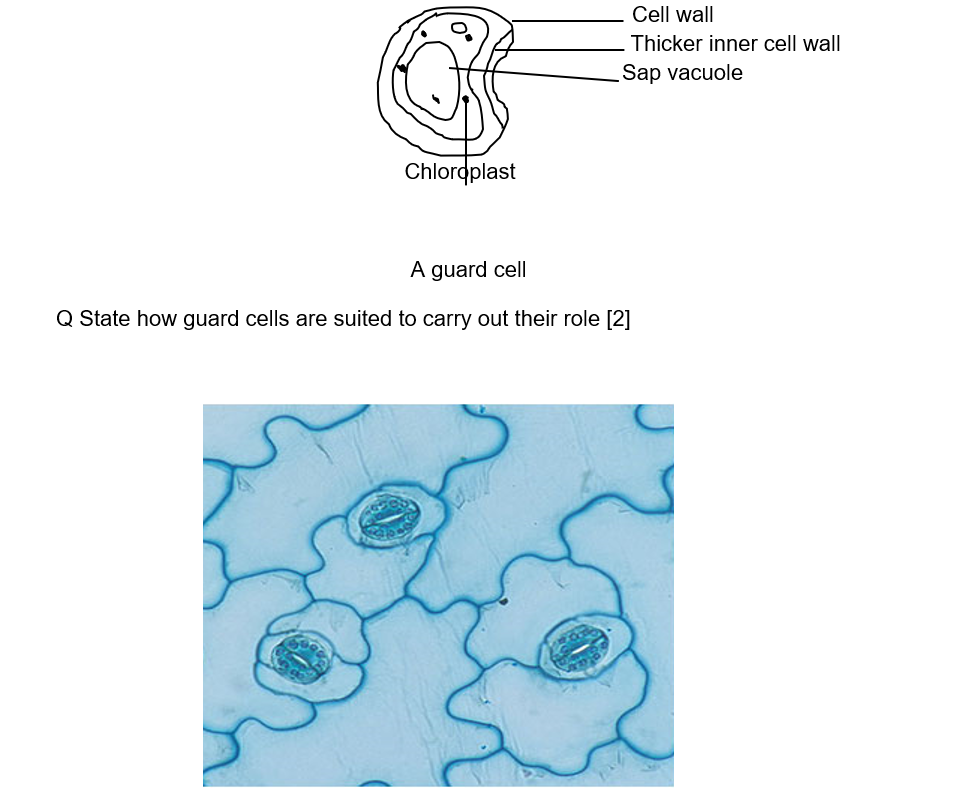
Surface view of lower epidermis of leaf of Kalanchoe sp.showing stomata and guard cells
Mechanism of Opening and Closing of Stomata
- According to photosynthetic theory, guard cells produce sugar through photosynthesis and this causes osmotic pressure of the sap vacuoles to increase.
- According to the starch-sugar interconversion theory, during daylight photosynthesis takes place in guard cells using CO2. This makes PH in the guard cells to rise, favouring the conversion of starch into glucose. This increases the osmotic pressure of sap vacuoles.
- As a result, guard cells absorb water by osmosis from adjacent cells and become turgid.
- Since the inner cell walls are thicker than the outer cell walls, the guard cells bulge outwards making the stomata to open.
- At night, sugar is converted to starch in guard cells.
- At night, CO2 accumulates in the guard cells resulting in lowering of PH.
- This favours the conversion of glucose to starch.
- Starch is osmotically inactive therefore, the osmotic pressure of guard cells falls
- The cells lose turgidity due to water loss to adjacent epidermal cells by osmosis
- Guard cells become flaccid and draw towards one another thereby closing the stomata.
Q Describe the mechanism of stomatal opening [5]
Q Describe the mechanism of stomatal closure [5]
Mechanism of Gaseous exchange in Plants
- Gaseous exchange takes place in aerial roots, stems and leaves
- There exists a concentration gradient btn atmospheric air and air inside the roots, stems or leaves
- O2 diffuses from the atmosphere where its concentration is high into the plant where its concentration is kept low due to respiration
- CO2 diffuses out of the plant as a metabolic waste product along a concentration gradient
- Stomata are modified according to habitat. In Xerophytes (plants adapted to living in desert conditions), stomata are small, few in number and are found mainly on the lower leaf surface. In some xerophytes, stomata are found in sunken pits. In others, stomata remain closed at day light, only opening partially at intervals to allow for gaseous exchange and open only at night. This reduces water loss by transpiration
- In hydrophytes (plants adapted to growing in water or swamps e.g. water lilies), stomata are large, and are more stomata on upper leaf surface than lower leaf surface. This allows the plants to release excess water by transpiration. Hydrophytes also have aerenchyma tissue with large air spaces to store air for gaseous exchange
- Mesophytes are plants that grow in areas with adequate water supply. They have fairly large number of stomata, of medium size and almost equal in number on both surfaces of leaves.
- Gaseous exchange also occurs through lenticels. These are openings on stems and roots formed by loosely packed corky cells. Gaseous exchange takes place on the moist surfaces of cells under the lenticels. Gaseous exchange takes place btn the interior of the plant and the outside by diffusion.
- In halophytes (plants that grow in muddy salty waters e.g. mangroves), gaseous exchange takes place in lenticels found in specialised aerial breathing roots called pneumatophores
The image below shows a transverse section of leaf of a Water Lily (Nymphaea sp.) Plants that are adapted for living in water are known as hydrophytes. The image shows a layer of tissue known as aerenchyma underneath the palisade layer. Aerenchyma contains large air spaces, which gives the leaves buoyancy, allowing them to float on the surface of the water. Stomata occur in the upper leaf epidermis of plants with floating leaves, allowing gas exchange with the air above. The cuticle is usually thin or absent from the leaves of hydrophytes. The high density of water gives support to the submerged leaves and stems, and there is a lack of the supporting tissues found more widely in mesophytes, such as collenchyma or sclerenchyma.
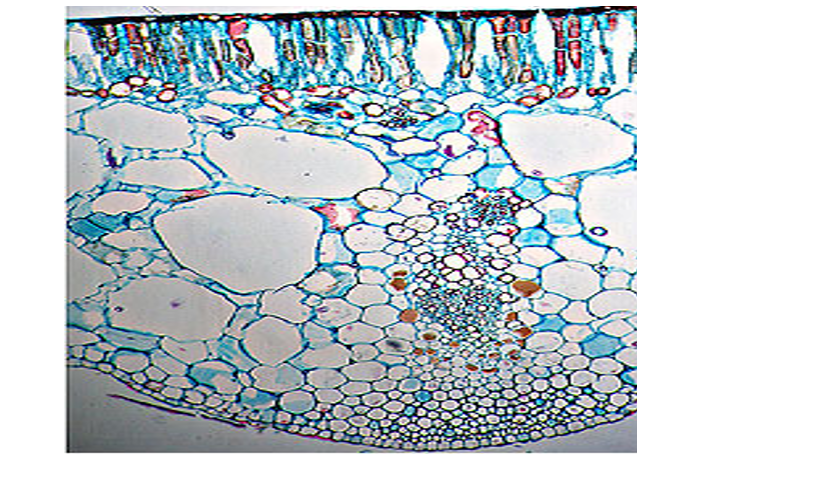
Q Explain the mechanism of gaseous exchange in plants [12]
Q State how the following structures are adapted to their function
- Aerenchyma [1]
- Lenticels [1]
- Pneumatophores [2]
Gaseous Exchange in Animals
Types of Respiratory Surfaces
- Cell membrane e.g. protozoa
- Gill filaments e.g. fish
- Tracheoles e.g. insects
- Alveoli/lungs e.g. mammals, birds, frogs, reptiles
- Skin e.g. frog, earthworm
- Buccal cavity e.g. frog
Characteristics of Respiratory Surfaces
- Large S/A
- Moist surface
- Rich capillary network
- Thin membrane
Gaseous Exchange in Protozoa e.g. Amoeba
- Amoeba are single-celled organisms that live under fresh water
- They have a large SA/V ratio exposed to water
- Thus, gaseous exchange takes place by diffusion alone very fast across the cell membrane
- O2 dissolved in water diffuses across the cell membrane into the cytoplasm
- CO2 and other soluble wastes diffuse out through the membrane into the water along a concentration gradient
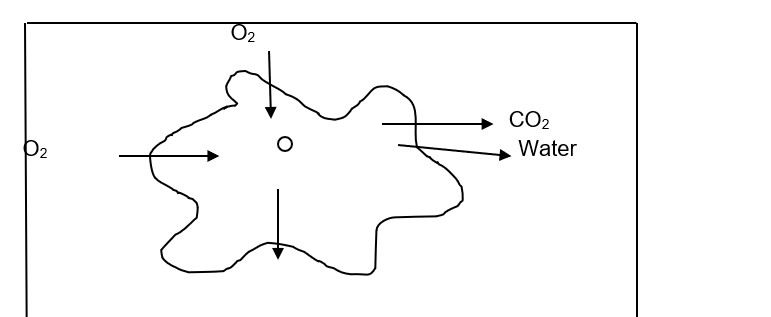
Gaseous Exchange in Insects
Structure and Function of the Tracheal System
- Spiracles are openings on either side of the abdomen and thorax thro which air enters and leaves the body
- Each spiracle has a muscular valve to control its opening and closing
- and hairs to prevent excessive loss of water from the body by evaporation
- Spiracles open into tubes called trachea that are in turn branched into tracheoles to increase S/A for gaseous exchange
- Bands of chitin support the air tubes to keep them open
- Tracheoles have thin moist walls for gases to dissolve and diffuse fast during gaseous exchange
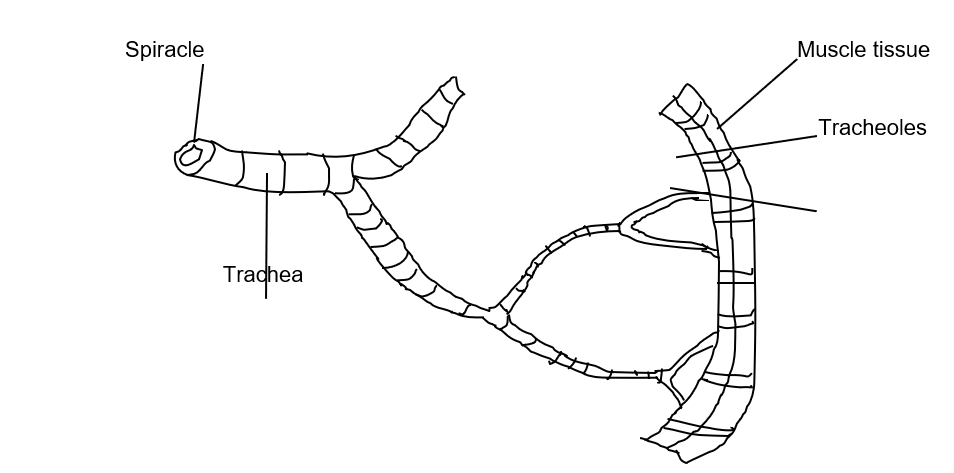
Q State four structural adaptive features of the insect tracheal system [4]
Mechanism of Gaseous Exchange in the Tracheal System of Insects
- Air is drawn into and out of the tracheal system by movement of muscles of abdominal wall
- When spiracle valves open, air is drawn into the tracheal system
- The valves then close and air is forced along the tracheal system by muscle movements
- O2 diffuses into the tissue fluid and into the cells due to higher O2 diffusion gradient
- CO2 diffuses out of tissue cells and into the tissue fluid and then into the tracheal system due to a CO2 diffusion gradient
- The thoracic spiracle valves close as the abdominal spiracle valves open
- CO2 is released through the spiracle openings in the abdomen
Explain how gaseous exchange occurs in terrestrial insects [7]
Gaseous Exchange in Fish
Structure and Function of Gills
- Numerous gill filaments provide large surface area for gaseous exchange
- Gill rakers prevent solids in water from reaching the delicate gill filaments
- Gills have blood capillaries to deliver oxygen and remove CO2
- Operculum is a bony plate that protects the gills
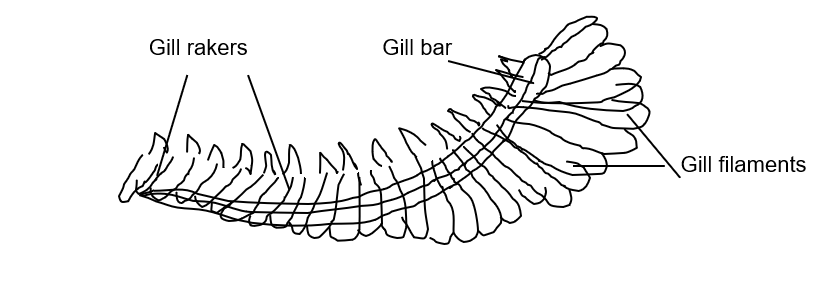
Mechanism of Gaseous Exchange in Bony Fish
- Gaseous exchange in fish occurs through gills
- During inhalation, muscular contractions lower the floor of the mouth cavity
- This increases volume of mouth cavity but reduces pressure
- As a result, water flows into the mouth through the open mouth cavity
- Each operculum bulges outwards to reduce pressure in the gill cavity
- This causes water containing dissolved O2 to flow from the mouth cavity to the gill chamber over the gills
- The mouth then closes and muscles raise the floor of the mouth cavity, this causes remaining water in the mouth to flow towards the gill chamber
- Water entering the mouth has a higher O2 concentration than in the gill filaments
- Therefore, O2 diffuses from water into the blood through the thin walls of capillaries
- O2 combines with haemoglobin and is transported to all parts of the body
- CO2 concentration in capillaries of gill filaments is higher than that in water
- This causes CO2 to diffuse out of the blood into the water through the walls of blood capillaries
- To facilitate maximum gaseous exchange, a steep concentration gradient is maintained by the water and blood in gill filaments flowing in opposite directions. This is the counter-current flow system.
Q Explain how gaseous exchange takes place in bony fish [13]
Gaseous Exchange in Mammals
Adaptive Features of the Breathing System in Mammals
Nose
- Has two openings to let in air into air passages
- Warms and moistens air to facilitate quick diffusion across alveoli
- Lining has hair shafts to trap dust/spores present in air
- lining has sense organs for smell to detect smell of air
Trachea
- A tube made up of rings of cartilage to prevent collapse
- Lumen with ciliated epithelium to move mucus and foreign particles upwards
Lungs
- Enclosed by pleural membrane for support onto thoracic cavity
- Pleural cavity filled with pleural fluid to reduce friction during breathing
- Numerous alveoli to increase SA for gaseous exchange
- Alveoli covered by dense network of capillaries to maintain steep diffusion gradient
- Thin epithelial wall to provide short distance for diffusion of gases
- Walls of alveoli are moist to allow gases to dissolve then diffuse across
- Detergent like fluid/ surfactant in alveoli lowers surface tension to prevent them from collapsing
- Lungs are spongy and elastic to allow expansion and relaxation during breathing
- Pleural membrane is airtight to allow pressure changes inside lungs without external influence
The Mechanism of Breathing
Inspiration
- External intercostal muscles contract while internal intercostals muscles relax
- This pulls rib cage upwards and outwards
- Diaphragm muscles contract making diaphragm to flatten
- Volume of thoracic cavity increases while pressure inside decreases
- Atmospheric pressure being higher than pressure inside thoracic cavity
- forces air to rush into the lungs through the nose and trachea hence inflating them
Expiration
- External intercostal muscles relax while internal intercostal muscles contract
- This brings rib cage down and inwards
- Diaphragm muscles relax and diaphragm regains its original dome shape
- Volume of thoracic cavity decrease and pressure inside it increases
- This forces air out of the lungs through the air passages into the atmosphere
Mechanism of Gaseous Exchange in the Alveolus
Plan diagram summarising gaseous exchange in the alveolus
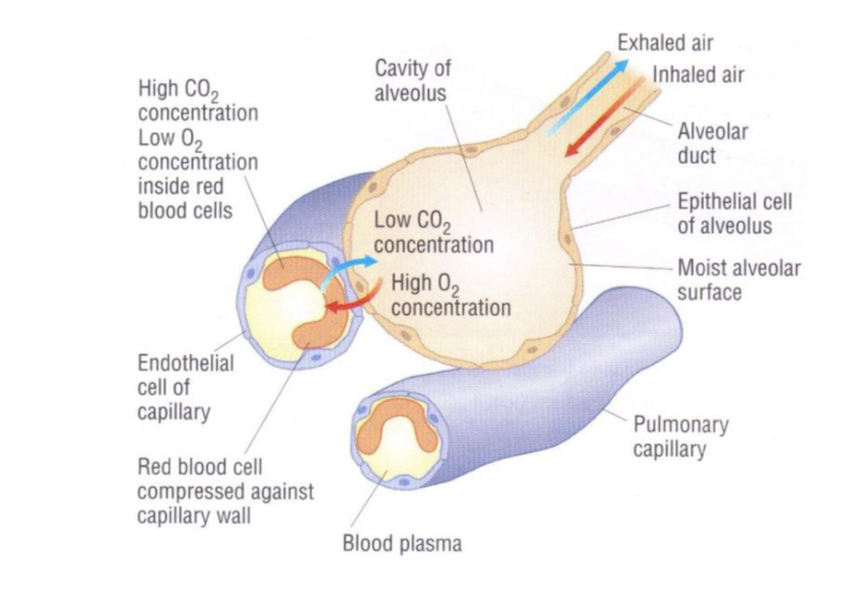
- Oxygen in inhaled air dissolves in film of moisture present in the wall of alveolus
- O2 concentration in RBCs inside blood capillaries surrounding the alveoli is lower than in the alveoli lumens
- Therefore, it diffuses through the alveolar epithelium, across the capillary wall, into the plasma and finally into the RBCs inside capillaries where it combines with haemoglobin
- CO2 in the RBCs inside the capillaries surrounding the alveoli is at a higher concentration than inside the alveoli lumens
- Hence, it diffuses out of the RBCs, into the blood plasma, across the capillary wall, across the alveolar wall into the alveolar lumen where it is exhaled
Q Describe how oxygen in air in the alveoli enters the blood in capillaries.
Q Give two ways in which capillaries are adapted for exchanging oxygen with the tissues
